BONE TUMORS
BONE TUMORS. By Dr. Ahmed Hosny. Clues by Appearance of Lesion Clues by Location of Lesion Clues by Density of Lesion Other Clues. Clues by Appearance of Lesion. Patterns of Bone Destruction Periosteal Reactions Tumor Matrix Expansile Lesions of Bone. Clues by Appearance of Lesion.
Share Presentation
Embed Code
Link
Download Presentation
- destructive lesion
- aneurysmal bone
- ewing
- mets brown
- lytic lesions
- simple bone cyst

shona + Follow
Download Presentation
BONE TUMORS
An Image/Link below is provided (as is) to download presentation Download Policy: Content on the Website is provided to you AS IS for your information and personal use and may not be sold / licensed / shared on other websites without getting consent from its author. Content is provided to you AS IS for your information and personal use only. Download presentation by click this link. While downloading, if for some reason you are not able to download a presentation, the publisher may have deleted the file from their server. During download, if you can't get a presentation, the file might be deleted by the publisher.
Presentation Transcript
- BONE TUMORS By Dr. Ahmed Hosny
- Clues by Appearance of Lesion • Clues by Location of Lesion • Clues by Density of Lesion • Other Clues
- Clues by Appearance of Lesion • Patterns of Bone Destruction • Periosteal Reactions • Tumor Matrix • Expansile Lesions of Bone
- Clues by Appearance of Lesion • Patterns of Bone Destruction • Geographic • Moth-eaten • Permeative
- Geographic Bone Destruction • Destructive lesion with sharply defined border • Implies a less-aggressive, more slow-growing, benign process • Narrow transition zone
- Patterns of Bone Destruction • Geographic • Moth-eaten • Permeative Non-ossifying fibroma
- Geographic Bone Destruction Examples: • Non-ossifying fibroma • Chondromyxoid fibroma • Eosinophilic granuloma
- Moth-eaten Bone Destruction • Areas of destruction with ragged borders • Implies more rapid growth • Probably a malignancy
- Patterns of Bone Destruction • Geographic • Moth-eaten • Permeative Multiple Myeloma
- Moth-eaten Bone Destruction Examples: • Myeloma • Metastases • Lymphoma • Ewing’s sarcoma
- PermeativeBone Destruction • Ill-defined lesion with multiple “worm-holes” • Spreads through marrow space • Wide transition zone • Implies an aggressive malignancy • Round-cell lesions
- Patterns of Bone Destruction • Geographic • Moth-eaten • Permeative Leukemia
- PermeativeBone Destruction Examples: • Lymphoma, leukemia • Ewing’s Sarcoma • Myeloma • Osteomyelitis • Neuroblastoma
- Less malignant Moremalignant Patterns of Bone Destruction • Moth-eaten Permeative Geographic
- Periosteal Reactions • Benign • None • Solid • More aggressive or malignant • Lamellated or onion peel • Sunburst • Codman’s triangle
- Periosteal Reactions • Benign • None • Solid • Aggressive/malignant • onion-peel • Sunburst • Codman’s triangle Non-ossifying fibroma
- Periosteal Reactions • Benign • None • Solid • Aggressive/malignant • onion-peel • Sunburst • Codman’s triangle Chronic osteomyelitis
- Periosteal Reactions • Benign • None • Solid • Aggressive/malignant • onion-peel • Sunburst • Codman’s triangle Ewing sarcoma
- Periosteal Reactions • Benign • None • Solid • Aggressive/malignant • onion-peel • Sunburst • Codman’s triangle Osteo-sarcoma
- Periosteal Reactions • Benign • None • Solid • Aggressive/malignant • onion-peel • Sunburst • Codman’s triangle Osteo-sarcoma
- Less malignant More malignant Periosteal Reactions Solid • Sunburst • onion-peel • Codman’s • triangle
- Tumor Matrix • Osteoblastic • Fluffy, cotton-like or cloud-like densities • Osteosarcoma • Cartilaginous • Comma-shaped, punctate, annular, popcorn-like • Enchondroma, chondrosarcoma, chondromyxoid fibroma
- Tumor Matrix • Osteoblastic • Cartilaginous
- Tumor Matrix • Osteoblastic • Fluffy, cotton-like or cloud-like densities as Osteosarcoma • Cartilaginous • Comma-shaped, punctate, annular, popcorn-like as Enchondroma, chondrosarcoma, chondromyxoid fibroma
- Tumor Matrix • Osteoblastic • Cartilaginous Chondrosarcoma
- Expansile Lesions of Bone • Multiple myeloma • Mets • Brown tumor • Enchondroma • Aneurysmal bone cyst • Fibrous dysplasia
- Expansile Lesions of Bone Multiple myeloma Mets Brown tumor Enchondroma Aneurysmal bone cyst Fibrous dysplasia
- Expansile Lesions of Bone Multiple myeloma Mets Brown tumor Enchondroma Aneurysmal bone cyst Fibrous dysplasia Renal cell carcinoma
- Expansile Lesions of Bone Multiple myeloma Mets Brown tumor Enchondroma Aneurysmal bone cyst Fibrous dysplasia
- Expansile Lesions of Bone Multiple myeloma Mets Brown tumor Enchondroma Aneurysmal bone cyst Fibrous dysplasia
- Expansile Lesions of Bone Multiple myeloma Mets Brown tumor Enchondroma Aneurysmal bone cyst Fibrous dysplasia
- Expansile Lesions of Bone Multiple myeloma Mets Brown tumor Enchondroma Aneurysmal bone cyst Fibrous dysplasia
- Clues by Location of Lesion • In the Transverse Plane • In the Longitudinal Plane • Characteristic Locations by tumors • Characteristic Tumors by Body Site • Pelvic Lesions • Expansile Rib Lesions • Lesions of the Spine
- . . . In the Transverse Plane
- In the longitudinal Plane • Epiphyseal GCT, chondroblastoma • Metaphyseal Osteomyelitis, osteo-and chondrosarcoma • Diaphyseal Round cell lesions, ABC, enchondroma
- Characteristic Locations • Simple bone cyst Proximal humerus • Chondroblastoma Epiphyses • Giant Cell tumor Epiphyses • Adamantinoma Tibia • Chordoma Sacrum, clivus • Osteoblastoma Spine, posterior
- Characteristic Locations • Simple bone cyst Proximal humerus • Chondroblastoma Epiphyses • Giant Cell tumor Epiphyses • Adamantinoma Tibia • Chordoma Sacrum, clivus • Osteoblastoma Spine, posterior
- Characteristic Locations • Simple bone cyst Proximal humerus • Chondroblastoma Epiphyses • Giant Cell tumor Epiphyses • Adamantinoma Tibia • Chordoma Sacrum, clivus • Osteoblastoma Spine, posterior
- Characteristic Locations • Simple bone cyst Proximal humerus • Chondroblastoma Epiphyses • Giant Cell tumor Epiphyses • Adamantinoma Tibia • Chordoma Sacrum, clivus • Osteoblastoma Spine, posterior
- Characteristic Locations • Simple bone cyst Proximal humerus • Chondroblastoma Epiphyses • Giant Cell tumor Epiphyses • Adamantinoma Tibia • Chordoma Sacrum, clivus • Osteoblastoma Spine, posterior
- Characteristic Locations • Simple bone cyst Proximal humerus • Chondroblastoma Epiphyses • Giant Cell tumor Epiphyses • Adamantinoma Tibia • Chordoma Sacrum, clivus • Osteoblastoma Spine, posterior
- Clues by Density of Lesion • Sclerotic Cortical Lesions • Lytic Lesions in Children • Lytic Lesions in Adults • Blastic Lesions in Children • Blastic Lesions in Adults
- Sclerotic Cortical Lesions • Osteoidosteoma • Brodie’s abscess
- Sclerotic Cortical Lesions • Osteoid osteoma • Brodie’sabscess
- Lytic Lesions in Children • Eosinophilicgranuloma • Leukemia
- Lytic Lesions in Children • Eosinophilic granuloma • Leukemia
- Lytic Lesions in Adults • Metastaticlesions • Lung • Renal • Thyroid • Multiple myeloma • Primary bone tumor Metastatic thyroid carcinoma
- Lytic Lesions in Adults • Metastatic lesions • Lung • Renal • Thyroid • Multiplemyeloma • Primary bone tumor
- Lytic Lesions in Adults • Metastatic lesions • Lung • Renal • Thyroid • Multiple myeloma • Primarybonetumor Chondrosarcoma
- Blastic Lesions in Children • Lymphoma Load More .

Bone tumors osama nimri
Bone tumors are rare tumorsaccounting for less than .2% of all cancers Occur more in young ages . Classification of Bone tumors. Origin: - primary - secondary: 95%, breast, lung, prostate, kidney and thyroid cell type: Bone? Osteoma, osteosarcoma Cartilage? Chondroma, Chondrosarcoma Marrow? Hemangioma, angiosarcomaFibrous tissue?Fibroma, fibrosarcomaTumor type:Benign: Osteoma, osteochondromaMalignant:: Osteosarcoma, chondrosarcoma .
731 views • 29 slides
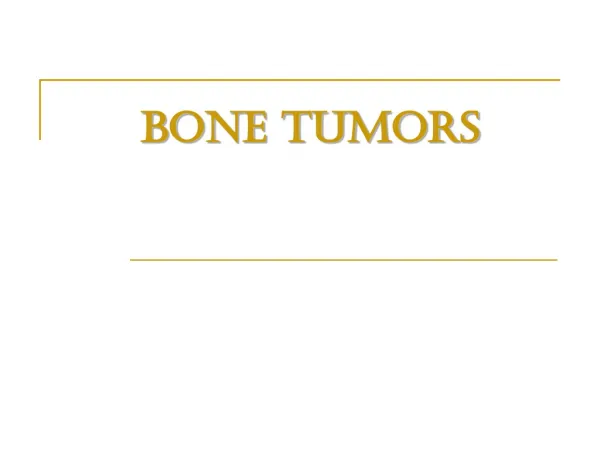
BONE TUMORS
BONE TUMORS. Bone tumors. Bone tumors are classified into: Primary bone tumors Secondary bone tumors ( Metastasis) Most are classified according to the normal cell of origin and apparent pattern of differentiation. Bone tumors. Bone-forming tumors Cartilage-forming tumors
2.21k views • 35 slides

BONE TUMORS
BONE TUMORS. By Dr. Ahmed Hosny. Clues by Appearance of Lesion Clues by Location of Lesion Clues by Density of Lesion Other Clues. Clues by Appearance of Lesion. Patterns of Bone Destruction Periosteal Reactions Tumor Matrix Expansile Lesions of Bone. Clues by Appearance of Lesion.
1.35k views • 59 slides

Primary Bone Tumors
Primary Bone Tumors . Courtney Gleason September 27, 2007. Bone Tumors. Bone tumors can be primary or secondary. Secondary (metastasis) tumors are the most common malignancy of bone. Primary bone tumors are divided into benign and malignant.
994 views • 12 slides

BONE TUMORS
BONE TUMORS. Bone tumors. Bone tumors are classified into: Primary bone tumors Secondary bone tumors ( Metastasis) Most are classified according to the normal cell of origin and apparent pattern of differentiation. Analytic approach to evaluation of the bone neoplasm. Evaluation.
2.13k views • 56 slides

Bone Tumors
. . 1. . (General consideration of bone tumors)2. . (Approach to diagnosis of bone tumors) 2.1 . (Clinical diagnosis) 2.2 . (Radiographic diagn
1.14k views • 50 slides
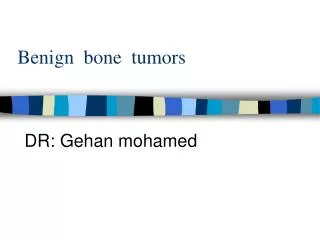
Benign bone tumors
Benign bone tumors. DR: Gehan mohamed. Benign bone tumors. Osteoma osteoid osteoma giant osteoid osteoma (osteoblastoma) osteochondroma. Definition of osteoma:. A benign tumor composed of bony tissue, often developing from the skull. Osteoma in the frontal sinus.
622 views • 20 slides

Review of Benign Bone TUMORS
Review of Benign Bone TUMORS. Scott Shelton, DPM R1. Common Benign Tumors/Lesions. Enchondroma, osteochondroma, non-ossifying fibroma, chondroblastoma, osteoid osteoma, osteoblastoma, periosteal chondroma, giant cell tumor, and chondromyxoid fibroma.
2.33k views • 32 slides

BONE TUMORS
BONE TUMORS . Primary bone tumors > metastases from other sites Primary bone tumors widely range -from benign to malignant. Classified according to the normal cell counterpart and line of differentiation. Among the benign tumors, osteochondroma s a re most common.
884 views • 20 slides
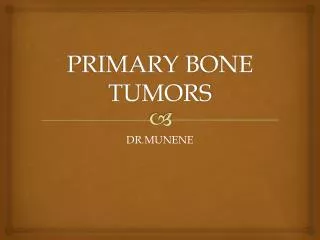
PRIMARY BONE TUMORS
PRIMARY BONE TUMORS. DR.MUNENE. BENIGN BONE TUMOURS. The generally are Solitary Localised Slow growing Enlarges by pressure and expansion Do not metastasize (though benign tumours like GCT and chondroblastoma have been known to metastasize). GENERAL CHARACTERISTICS OF BONE TUMOURS
1.67k views • 119 slides

Bone Tumors and Fractures
Bone Tumors and Fractures. Stacy Fielding. OSA, CSA, FSA Solitary Metaphyseal location Long bones Rich blood supply “Away from elbow, toward the knee” Late stage disease Invade adjacent bones Cross joints Adjacent parenchymal organs. Primary Bone Tumors. www.marvistavet.com.
511 views • 14 slides

Bone Tumors
Bone Tumors. Prof. Hussien Gadalla. General considerations. Primary bone tumors are much less than secondary tumors. All age groups affected, but some tumors occur in certain age Almost every bone can be affected, but some tumors prefer certain location
929 views • 18 slides
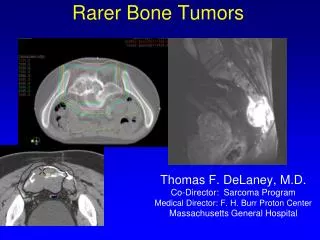
Rarer Bone Tumors
Rarer Bone Tumors. Thomas F. DeLaney, M.D. Co-Director: Sarcoma Program Medical Director: F. H. Burr Proton Center Massachusetts General Hospital. Overall survival for all 171 pts was: 48% at 1 year 24% at 2 years 12% at 3 years 6% at 4 years 2% at 5 years
227 views • 9 slides

Chemotherapy For Common Bone Tumors
Chemotherapy For Common Bone Tumors. G Naheed Usmani, MD Division of Pediatric Oncology/Hematology University of Massachusetts Medical Center. Osteogenic Sarcoma. Prognostic Factors For OS. Extent of disease at diagnosis: metastatic vs nonmetastatic
616 views • 37 slides

Tumors of bone
Tumors of bone. Tumors of bone. - Cause usually unknown (Primary, idiopathic) - Genetic factors may play a role (p53 and RB mutations) - Bone infarcts, trauma, osteomyelitis, Pagets disease, radiation and metal prosthesis predispose to tumors. Tumors of bone. - Clinical presentation
4.42k views • 36 slides

Bone tumors
Bone tumors. 1-Primary bone tumors Benign Malignant 2- Secondary (metastatic) bone tumors. [I] Primary Bone Tumors. I. Bone Forming Tumors (Osteoblastic) They are characterized by osteoid formation by Tumor cells. (A) Benign Tumors: Osteoma, Osteoid osteoma, and Osteoblastoma
1.08k views • 37 slides
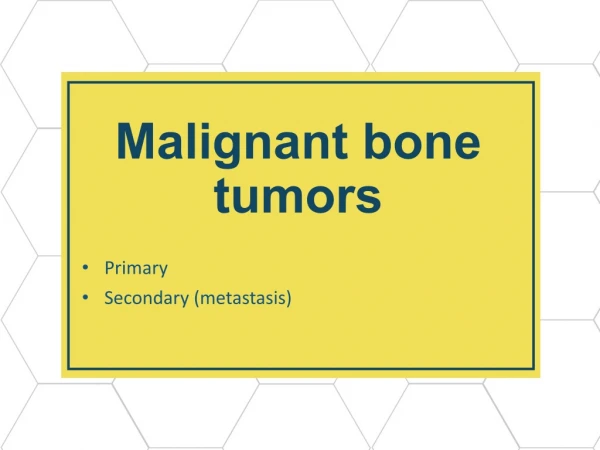
Malignant bone tumors
Malignant bone tumors. Primary Secondary (metastasis). Primary malignant tumors. Multiple myeloma Osteosarcoma Ewing sarcoma Chondrosarcoma. Uncommon cancer Most commonly affects the long bones 20 % of pediatric bone tumors are malignant.
793 views • 44 slides

Benign bone tumors
Benign bone tumors. Classification. Bone tissue (osteoma, osteoid osteoma, osteoblastoma) Cartilage tissue (chondroma, osteochondroma, chondroblastoma, chondromyxoid fibroma) Fibrous tissue (fibroma, fibrous histiocytoma) Vascular tissue (hemangioma, glomus tumor, hemangiopericytoma
543 views • 27 slides




















